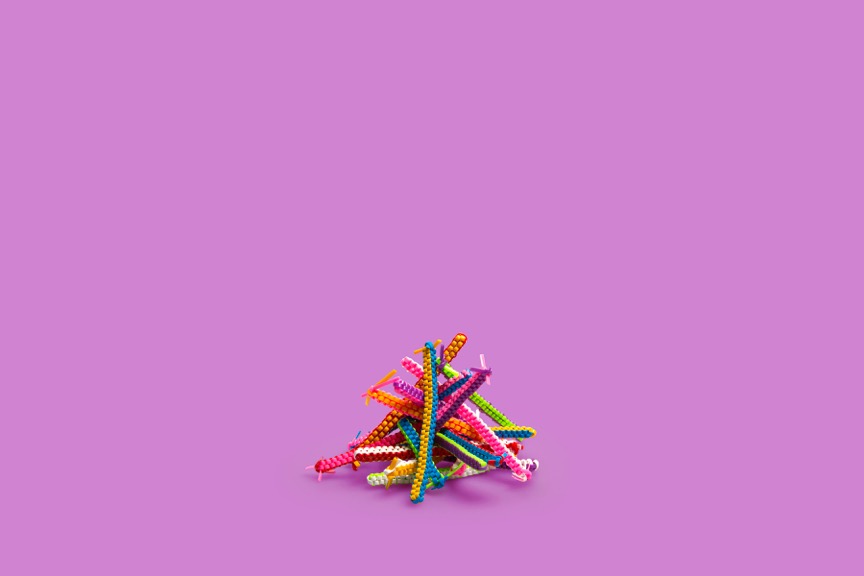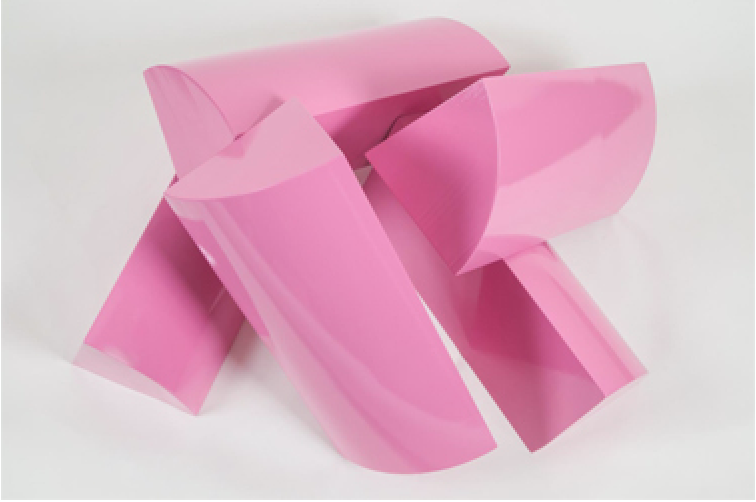Happiness Project by Didi Dunphy is a critical examination of high design via commodification, craft and fantasy. Her emphasis lies within the making of each piece, the things unseen.
QVC, a startling collection of photographs of gorgeous rings displayed against pink backgrounds with doily-like borders, is a fantastical exploration of the commodity. Despite the piece’s obvious allusion to QVC, the shopping TV channel, the images cite more than simply online shopping desires. The depictions of individual rings draw attention not only to their own intricacies and precious stones, but to the human hand, the wearer, the individual behind the jewelry. Though none of the images acknowledge in any way, other than that they are objects for hands themselves, the wearer or the individual, their congruence along an entire wall of whitespace paints a portrait of ownership. QVC is a portrait, perhaps not of any one specific individual, but of the nature of the commodity itself. Rings are objects of personal augmentation, and though they are mere objects, there is a story behind the acquisition of each one. In displaying images of jewelry meant to be worn, what is unseen is precisely what is emphasized, in this case, humanity and its relationship to the commodity. In QVC, the viewer is presented only with the rings themselves, left to wonder about the rest, the story, the history. The viewer must discern information from the presentation of each individual ring in order to come to a conclusion, or simply enjoy the pieces as commodities themselves.
Not only do these rings cite the luxury of owning such objects, but other pieces, like Industrial Emoticon tip their caps, so to speak, to the banal. Dunphy, of course, in her project elevates these commonplace, albeit elegant, items to the lavish and fantastical. Industrial Emoticon alludes to the iconic 1960’s Arco lamp, a lavish commodity for any home during its peak of popularity. The overblown happy face, clouds and heart cut from plexiglass alter the iconic images of the Arco towards the fanciful and imaginative, taking high design to a place of play and visual communication. The bright colors and overblown qualities cite artists like Jeff Koons. Through Dunphy’s attention to popular culture depictions of emoticons and her alteration of the Arco, the banal is transformed into the unique, shiny and effervescent. Here, Dunphy has elevated previous conceptions of luxury objects to pop culture expressions of emotion. Alluding to the emoji, an emoticon used for expression, Dunphy juxtaposes the classic and iconic with the contemporary and technological.
 Didi Dunphy, Campfire, 24 x 36 inches, lambda print on fuji flex mounted on plexi
Didi Dunphy, Campfire, 24 x 36 inches, lambda print on fuji flex mounted on plexi
Other designs similarly reference iconic objects and images. Hanging Garden mirrors a 70s shell lamp or night club curtains. All the Things I Can’t Live Without: Nails depicts images of Piet Mondrian’s Compositions with Red, Blue and Yellow, accomplishing similar messages of commodifying high art. Other acrylic nails depict images of hello kitty, clouds, colorful squares and flowers. These images, like QVC cite the hand, the individual behind each set of nails. Compared to Dunphy’s five intricately embroidered pieces, all place an emphasis on color, its brightness and shine, as well as handiwork, the work of craft. Both acrylic nail painting and embroidery are typically female gendered crafts and both represent objects acquired out of luxury or excess. Both reference the individual behind the work, the person who accomplished the project.
Several other pieces depict images of campfires, from sketches with smoke crafted from brightly colored and holographic teacher’s pet stickers, to a large hot-pink plexiglass print of woven colorful lanyards to Dunphy’s pink Donald Judd-like sculpture depicted below. These images reference the joys of childhood, the simplicity of that childhood happiness and the escape of camp. Placed next to Faerie Ring, photographs of faerie circle mushrooms, works like Picket, a fluorescent aluminum 8-foot propped fence and Twins, two chain link and picket fence tiaras, similarly to All the Things I Can’t Live Without: Nails, take part in depicting the other side of luxury, the hard work behind the exquisite. In some way, all of Dunphy’s work cites the excess of high design and extravagant living, and yet also references hard work, the skill of craft and the conceptual elements behind these facades of brightly colored, shiny beauty. Dunphy’s conceptual work is illuminated in this space between craft and luxury. Her attention to the intersections between design, pop culture, feminity, fantasy, and the unseen, are truly what make Happiness Project, an examination of much more than the objects themselves, but the conceptual as well.

Didi Dunphy, Fire Logs, size variable, wood, airbrushed paint
Written by: Hilleary Gramling